Mosses, Liverworts, and Lichens
Media
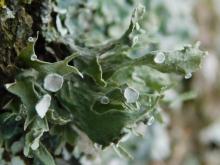
Species Types
Scientific Name
Ramalina spp.
Description
Twig lichens, or ramalina lichens, are branching, shrubby lichens that grow in tufts from a single point. They are grayish green, and the branches are distinctively flattened.
Media
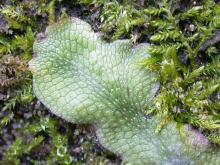
Species Types
Scientific Name
About 112 species in Missouri
Description
Liverworts, along with mosses, make forest floors, streamsides, and spring openings beautiful. They’re fascinating but overlooked.
Media
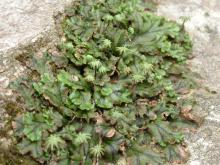
Species Types
Scientific Name
Marchantia polymorpha
Description
Umbrella liverwort is the most famous liverwort in the world. It grows in green ribbons and is very common on the soil of potted plants. It typically forms cuplike gemmae on its upper surface. Its palm-tree-shaped archegona are distinctive, too.
Media

Species Types
Scientific Name
Parmotrema spp.
Description
Ruffle lichens are rather large, broad-lobed foliose lichens that are loosely attached to the substrate. The rounded edges of the lobes usually lift up and look ruffled. Hairlike cilia arise from the lobe edges. They usually grow on tree bark.
Media
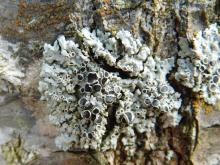
Species Types
Scientific Name
Physcia stellaris
Description
The star rosette lichen is a super common, small foliose lichen that most often grows on trees, including trunks, limbs, and twigs. The pale gray thallus has branching, petal-like lobes. The center of the rosette is almost always crowded with apothecia cups with black or dark gray centers.
Media
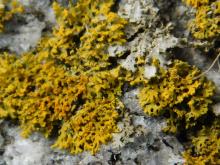
Species Types
Scientific Name
Xanthoria spp. (also Xanthomendoza; Polycauliona)
Description
Orange sunburst lichens are orange or yellow orange. They have a circular, foliose growth pattern with tiny, branching lobes, but this pattern is often lost when these lichens form masses of tiny scale-like fragments. They can be very common on sunny rocks and tombstones.
Media
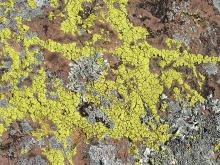
Species Types
Scientific Name
Acarospora spp.
Description
Cobblestone lichens , or cracked lichens, grow flat against their substrate and are textured like lumpy cobblestone streets or old, cracked paint, or they are broken into sections like the mud of a dried lake. Depending on species, the color can range from white to greenish gray to brown to bright yellow.
Media
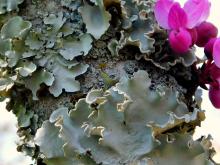
Species Types
Scientific Name
About 436 species in Missouri
Description
A lichen is a composite organism formed by certain fungus species that join with certain algae species. Lichens can be many colors and can be crusty, leaflike, flaky, branching, or mossy. They grow on rocks, trees, or other surfaces.
Media

Species Types
Scientific Name
Caloplaca spp.
Description
Firedot lichens are usually orange, yellow, rusty, or brown and look like tiny dots on a surface. To see these crustose lichens well, you often must get on your hands and knees and use a hand lens.
Media
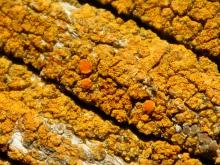
Species Types
Scientific Name
Candelariella spp.
Description
Goldspeck lichens are orange to yellow crustose lichens that are frequently seen growing on rocks, wood, or other substrates. Missouri has about three species.
See Also
About Mosses, Liverworts, and Lichens in Missouri
Mosses, liverworts, hornworts, and lichens seem rather similar, but these organisms are in very different groups. Mosses, liverworts, and hornworts are small, low plants usually found in damp habitats. Unlike more familiar plants, they lack veinlike structures and do not produce flowers or seeds — instead, they produce spores. Meanwhile, lichens are not plants at all: they are a collection of different fungi that have photosynthetic algae living within their tissues.





















